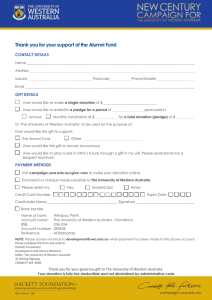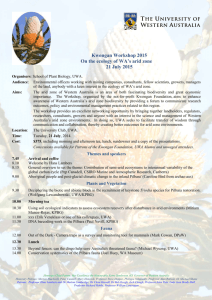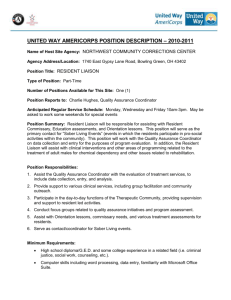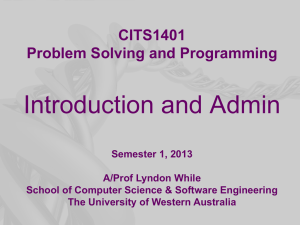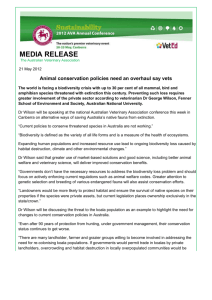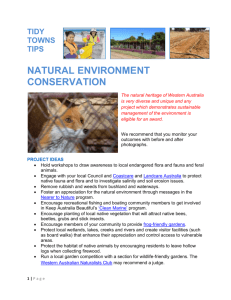Organisation chart - The University of Western Australia
advertisement
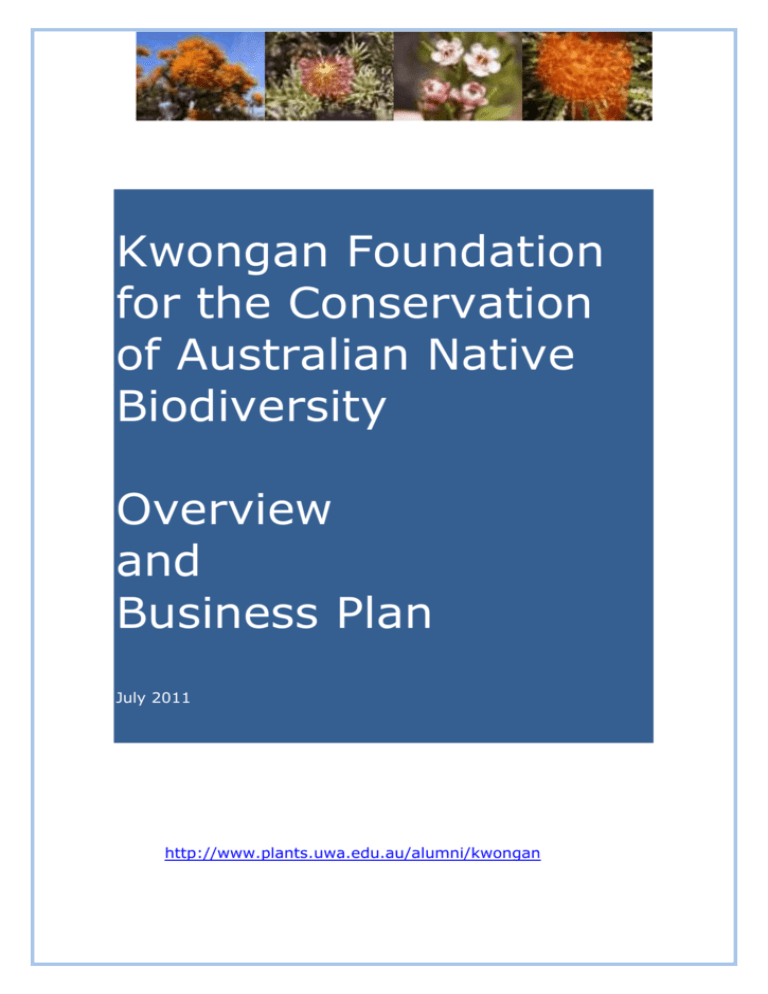
Kwongan Foundation for the Conservation of Australian Native Biodiversity Overview and Business Plan July 2011 http://www.plants.uwa.edu.au/alumni/kwongan UWA SPB Kwongan Foundation Business Plan 2011 - 2015 Table of Contents OVERVIEW..................................................................................... 3 BUSINESS PLAN SUMMARY ............................................................ 7 The Business................................................................................. 7 The Market ................................................................................... 7 The Future .................................................................................... 8 The Finances ................................................................................. 8 THE BUSINESS ............................................................................... 8 Business details............................................................................. 8 Foundation details ......................................................................... 8 Foundation premises ...................................................................... 8 Organisation chart ......................................................................... 9 Management ................................................................................. 9 Key personnel ............................................................................... 9 Products/services ........................................................................ 10 Risk management ........................................................................ 12 Operations .................................................................................. 14 THE MARKET ................................................................................ 15 Market targets ............................................................................ 15 S.W.O.T. analysis ........................................................................ 17 Your competitors ......................................................................... 18 THE FUTURE ................................................................................ 18 Vision statement ......................................................................... 18 Mission statement ....................................................................... 18 Goals/objectives .......................................................................... 18 Action plan ................................................................................. 18 THE FINANCES ............................................................................. 19 Key objectives and financial review ................................................ 19 Assumptions ............................................................................... 19 Page 2 UWA SPB Kwongan Foundation Business Plan 2011 - 2015 Overview The University of Western Australia Kwongan Foundation The Kwongan Foundation for Australian Native Biodiversity has been established to promote better understanding, management and utilisation of Western Australia’s unique native biological resources The Name Kwongan is a Noongar Aboriginal term defined by Beard as a ‘type of country ...[that is] sandy and is open without timber-sized trees but with a scrubby vegetation. It consists of plains in an Australian sense of open country rather than in a strict sense of flat country. ... there are two principal plant formations in the kwongan, scrub heath and broombush thicket ... both ... are sclerophyll shrublands and possess a certain unity when contrasted with woodland and forest or steppe and succulent steppe communities.’ Message from the Vice-Chancellor “Western Australia is an ancient land mass with unique geology and soils; these combined with its climate have led to the evolution of an especially diverse, complex and interesting biodiversity that is rich in its beauty, adaptations, specialisations and relationships. The plants of Western Australia in particular have the potential to reveal new insights in how organisms relate to each other and their environment and to provide resources relevant to human health as well as to improved agricultural productivity and sustainability. The specialised nature of the flora along with its complex and subtle interactions with other organisms make it highly susceptible to human induced environmental changes whether they be climate change, soil salinity and acidification, altered fire regimes, clearing, cultivation and grazing or the introduction of weeds, pests and diseases. The School of Plant Sciences at the University of Western Australia is one of the country’s leading institutions in its field. Amongst its compliment of staff we have the expertise to understand our native flora and to address and integrate all of the factors impinging on its preservation, management and utilisation. The Kwongan Foundation has been established by the School of Plant Sciences to provide a focus for its contribution to improved awareness, understanding, management and utilisation of Western Australia’s biodiversity and to enhance the human capital available to achieve these outcomes.” The flora of Western Australia – where the rules of plant biology are tested to destruction Page 3 UWA SPB Kwongan Foundation Business Plan 2011 - 2015 The abject infertility of the native soils of south-western Australia and the intense summer drought that is part of the Mediterranean climate have together produced native plants and ecosystems that have developed a range of unique means of surviving and reproducing. Some of the notable adaptations to be observed amongst the Western Australian flora include: A preponderance and wide range, of symbiotic and parasitic relationships Proteoid roots Drought tolerance mechanisms Insect mimicry Low phosphate tolerance Resultant features of the flora of Western Australia are the very large number of constituent species and the very high species densities that occur in different parts of the State. This species diversity and density and the extensive clearing of the landscape over the past 180 years, has caused the south-western corner of Western Australia to be recognised as one of only 25 Biodiversity hotspots in the world and the only one in Australia. A biodiversity hotspot is a biogeographic region with a significant reservoir of biodiversity that is under threat from humans. University of Western Australia – School of Plant Biology The University of Western Australia School Of Plant Biology is a research intensive school addressing humanity’s top four priorities - Food, Water, Energy and Environment through research and teaching focused on commercial cropping, marine and natural terrestrial systems. The University of Western Australia School of Plant Biology’s strengths lie in its: Capacity for strategic plant sciences Expertise in fundamental, cutting-edge research Positive links with industry Relationships with other institutions including: o WA Department of Food and Agriculture (Two shared academic positions) o WA Department of Environment and Conservation(Two shared academic positions) o CSIRO (One shared academic position) The School’s resources include More than twenty academic teaching staff More than thirty-five academic research staff About one hundred and twenty postgraduate research students. The teaching and research staff include four academics on the ISI List of Highly Cited Scientists (top 0.5% in their field in the world) and one national Laureate Fellow. The School is Australia’s leading plant sciences institute, in both numbers of publications and numbers of citations per year The Kwongan Foundation for the Conservation of Australian Biodiversity was established in 2006 to: gather and share of knowledge about our unique biodiversity enable planning on a long-term basis for conservation of these species Page 4 UWA SPB Kwongan Foundation Business Plan 2011 - 2015 attract world-class researchers to Western Australia to achieve significant advances and stem the tide of looming extinction for so many species address new problems as they arise facilitate community, industry and Government conservation objectives help provide a secure basis for the State's tourist industry discover valuable compounds for medicine and industry involve community groups helping with these challenges The Foundation also aims to provide essential support to promising young researchers in this important field. The Kwongan Foundation provides an opportunity for all with a commercial, personal or academic interest in the flora of Western Australia to directly contribute to our knowledge, utilisation and management of this unique resource. Current Activities: Currently the Kwongan foundation pursues its objectives through: The conduct of conferences and excursions that: o Provide a forum for the sharing of information on the biodiversity of Western Australia, the threats and opportunities facing it and best practice management of these threats and challenges o Assist in the identification of aspects of the knowledge of the biodiversity of Western Australia that require research and elucidation o Allow interested community members to interact with those with expertise in the biodiversity of Western Australia and its management. The funding of research scholarships for young people with an interest in developing expertise in the biodiversity of Western Australia and its management and in communicating this knowledge to others with an interest in this flora as well as to the broader community. Previous events Development and Biodiversity - can they co-exist? Kwongan Colloquium, Busselton WA, 18-19 Sep 2010 On the ecology of WA's arid zone Workshop, UWA, 29 Jun 2010 Biodiversity in the wheatbelt: where do we go in the 21st century? Seminar and field trip, York WA, 12 - 13 Sept 2009 Biodiversity on the Verge Seminar and field trip, UWA, 13 - 14 Sept 2008 Management of the Foundation The operations and administration of the Kwongan Foundation are managed within the University of Western Australia’s School of Plant Biology and coordinated by the Head of that School and Patron of the Foundation, Winthrop Professor Hans Lambers. Patrons Professor Hans Lambers Dr Marion Cambridge Page 5 UWA SPB Kwongan Foundation Business Plan 2011 - 2015 Dr Rob Keogh Dr Cleve Hassell Mr Jock Clough Professor John Pate Lady Jean Brodie-Hall Honorary Patrons Professor Alan Robson, Vice Chancellor, UWA Mr. Peter Cundell Ms Marion Blackwell Professor Steve Hopper, Director Royal Botanic Gardens at Kew Ms Philippa Nikulinsky Donations Donations to the Kwongan Foundation may be made in the form of cash, property (shares, real estate etc.) and/or trading stock and may be made in instalments. Funds raised for the Foundation are managed and invested by the University of Western Australia’s Office of Development and Alumni Relations and are not diminished by administration and/or operational costs. The University of Western Australia (ABN 37 882 317 280) is endorsed by the Australian Taxation Office (ATO) as a Deductible Gift Recipient (DGR) organisation, therefore all donations to the University are deductible as charitable contributions under the ATO provisions. Page 6 UWA SPB Kwongan Foundation Business Plan 2011 - 2015 Business Plan Summary The Business Business name Kwongan Foundation for the Conservation of Australian Native Biodiversity Business structure: Not for profit foundation within the University of Western Australia Hackett Foundation, a Deductible Gift Recipient organisation ABN 37 882 817 280 (University of Western Australia) Business location School of Plant Biology, the University of Western Australia, Crawley, WA 6009 Date established 2006 Products/services The coordination and conduct of colloquia/workshops/symposia/conferences which address objectives relating to the conservation of Australian native plants. The funding of post-graduate scholarships for promising researchers in the field The Market Target market The Kwongan foundation’s target market includes those elements of the following sectors with an interest in the native biodiversity of Western Australia. Industry: - Mining, Oil & Gas, Agriculture & forestry, Land development and Tourism Infrastructure - Private, State and Local government Legislative and Regulatory –Commonwealth, State and Local Government Consulting services – Environmental, Planning, Legal and Land management Academic & scientific Conservationism – DEC, BGPA Community - Local land-care and conservancy groups Marketing strategy Consultation with targets to ensure offerings address their needs and interests. Page 7 UWA SPB Kwongan Foundation Business Plan 2011 - 2015 The Future Vision statement Western Australians are proudly committed to the management and conservation of the State’s unique native biodiversity. Goals/objectives provide resources for research and study at UWA implement the gathering and sharing of knowledge enable long-term planning attract world-class researchers achieve tangible improvements in the long-term conservation prospects of endangered species and associations. The Finances The Foundation requires a fund of at least $2,000,000 to sustain its activities. The Business Business details The Kwongan Foundation for the conservation of Australian native plants has been established to: provide resources for research and study at UWA implement the gathering and sharing of knowledge enable long-term planning attract world-class researchers achieve tangible improvements in the long-term conservation prospects of endangered plants. Foundation details Name: University of Western Australia -Kwongan Foundation for the Conservation of Australian Native Plants Established: 2006 Location: University of Western Australia, Crawley WA 6009 Structure: Not for profit foundation within the University of Western Australia Hackett Foundation, a Deductible Gift Recipient organisation ABN: 37 882 817 280 (University of Western Australia) Foundation premises Location: The Kwongan Foundation operates from the offices of the School of Plant Biology (SPB) on the Crawley Campus of the University of Western Australia Page 8 UWA SPB Kwongan Foundation Business Plan 2011 - 2015 Organisation chart Prof. Hans Lambers Patron/Chair Patrons (7) Honorary Patrons (5) UWA Office of Development and Alumni Relations Financial Control Ms Barbara Jamieson Executive Assistant Figure 1: Organisation Chart. Management Details of management The Foundation is managed by Professor Hans Lambers. Management of the Foundation is additional to Lambers’ other duties which currently include Head of the SPB at UWA. Executive and clerical assistance in the management of the Foundation and his other roles is provided to Lambers by Barbara Jamieson. Funds raised for the Foundation are invested and managed by the UWA Office of Development and Alumni Relations. This service is performed as part of the management of the larger Hackett Foundation funding. The foundation, at this stage has no staff and pays no salaries. Experience Lambers is a well-established, academic, university teacher and administrator with an international reputation in his field of scientific research which is highly relevant to the objectives of the Foundation. Key personnel Current staff As specified above the foundation has no dedicated staff but leverages the resources of the SPB and other elements of UWA as well as other institutions (notably the Western Australian Government Botanic Gardens and Parks Authority (BGPA) and Department of Environment and Conservation, companies and individuals (on a voluntary basis) with which it shares objectives and interests. Required staff Page 9 UWA SPB Kwongan Foundation Business Plan 2011 - 2015 Neither this plan nor the business model upon which the Foundation was established, anticipate that the Foundation would employ its own staff. The current arrangements outlined above are expected to continue to provide the basis for the on-going activities of the Foundation. This model is largely considered to be sustainable within the short to medium term whilst Lambers is involved in and committed to, the Foundation. As is considered later in the risk analysis element of this plan, the progress and effectiveness of the Foundation in the absence of Lambers is a matter for consideration and resolution. Products/services The Foundation has one current “product” and its objectives commit it to a second. The current “product” is the coordination and conduct of Kwongan colloquia/workshops/symposia/conferences which address two of its objectives relating to the conservation of native plants: implement the gathering and sharing of knowledge achieve tangible improvements in the long-term conservation prospects of endangered plants. So far the Foundation has conducted six such events the first being held in 2007 with two in 2008 one in 2009 and two in 2010. The second and as yet unrealised “product”, the funding of post-graduate scholarships for promising researchers in the field addresses two of the other objectives of the Foundation: provide resources for research and study at UWA attract world-class researchers Development of the second product is contingent upon two factors; the first being the availability of adequate funds to offer one complete scholarship and contribute to two others, sufficient to attract appropriate candidates and the second being the identification of suitable candidates. As things currently stand the Foundation is unable to satisfy the first criterion so the second is not yet relevant. When implemented and taken together these “products” should allow the Foundation to realise its fifth objective: enable long-term planning Market position The colloquia/workshops/symposia/conferences coordinated by the Foundation occupy an interesting position in the range of such events that occur during a year. Whilst they do not rank with the major national and international academic and scientific plant biology conventions/congresses they invariably include contributors who have international standing at such forums as well as people with experience in managing or seeking to manage the conservation of native plants in various settings and experienced and expert amateurs. Neither do the Kwongan events compete with the offerings of the “convention industry” (e.g. IQPC’s 4th annual Environmental Management in Mining) which Page 10 UWA SPB Kwongan Foundation Business Plan 2011 - 2015 targets particularly the mining and land development industries and the legal, environmental, engineering and planning professions with high cost events usually addressing issues associated with the legal and regulatory responsibilities and processes facing these industries. This is not to say that the Foundation’s events are not highly relevant to some or all of the sectors served by the “convention industry” or that the contributors to the Kwongan events could not also present to such “conventions”. Unique selling position The Kwongan Foundation’s seminars have two characteristics that may not make them unique but do separate them from many other offerings. First, by virtue of the subject areas covered and the low cost of attendance they have the potential for broad appeal including academics, government and industry as well as interested amateurs. Second, the proximity of the Kwongan vegetation type to the Foundation’s location at UWA makes it practicable to include field visits and activities into event programmes. Anticipated demand The prospect that the activities of the Kwongan Foundation (both seminars and research) will be relevant to an increasing range of people and interests is strong. Drivers for this strong and probably growing interest include: The diversity of species, their adaptations and associations inherent in the flora of Western Australia and the Kwongan region in particular should ensure growing academic and amateur interest in the offerings the Foundation. The strong growth in the mining and energy industries and therefore population in Western Australia will ensure that the requirement to clear native vegetation in this state will continue and with that the pressures to better understand, manage and conserve and restore biodiversity, particular species and associations, the defined territory of the Foundation, will also grow. World population growth and the impact of climate change on the agricultural areas of south-western Australia separately and together are likely to result in growing interest in Kwongan vegetation as a potential source of solutions to the challenge of achieving sustainable agricultural production under circumstances of adverse climatic and soil conditions. The pressures of climate change and soil salinisation in south-western Australia may well render significant and growing developed areas of this region no longer suitable for commercial agriculture; in this event, revegetation by restoration of original species will be a desirable objective requiring significant research, development and extension – all aspects consistent with the objectives of the foundation. Page 11 UWA SPB Kwongan Foundation Business Plan 2011 - 2015 Risk management The Kwongan Foundation at this time faces two major risks. The first is that the Foundation is very heavily dependent on the interest, inspiration and commitment of its founding Patron, Professor Hans Lambers. In the absence of input like his, as things stand it is almost certain that the Foundation would first stagnate and then atrophy. The second major risk relates to the funding of the Foundation. At present the total of funds is sufficient to sustain the relatively modest annual program of colloquia/workshops/symposia/conferences and field visits, especially as much of the administration and communication activities are performed by staff of UWA at no charge to the Foundation. The present funds however are not sufficient to support the intended award of scholarships and part scholarships. Until adequate funds are accumulated the Foundation cannot fulfil its objectives and when it does the funding risk increases because of the longer term nature of the commitment associated with a scholarship. Furthermore, these two risks are linked and compounded to the extent that what funds have been raised are largely the result of the direct efforts of Professor Lambers. A lesser but still significant risk relates to maintenance of the quality and relevance of the colloquia/workshops/symposia/conferences that the Foundation conducts. An analysis of these risks is summarised below: Page 12 UWA SPB Kwongan Foundation Business Plan 2011 - 2015 Risk Likelihood Impact Strategy Management: Loss of, or a significant reduction in the services provided by Professor Lambers Short-medium term- Unlikely Longer termInevitable Very High Progressively move to a structure where the future of the Foundation is not so heavily dependent on the efforts of an individual. This might have two elements, first, the establishment of a voluntary Board charged with the oversight of the Foundation; second, include coordination of the Foundation in the duties of a senior member of the School of Plant Biology with a passion for Australian native biodiversity. Funding Highly unlikely Very High Maintain activities at a level consistent with current funding – (interest only) 2. Unable to raise additional funds to support expanded activities particularly post graduate scholarship/s and postdoctoral fellowships Possible High Quality and relevance of conference program fails to attract adequate level of interest from target audiences Possible 1. Inadequate funds to sustain current level of activities 1. Establish a fund-raising sub-committee of the Board of the foundation working to agreed fundraising targets. 2. Ensure undertakings do not exceed capacity of funds to sustain level of commitments Medium - High 1. Maintain contact with target groups to identify topics of interest 2. Include “representatives” of target groups on conference programmes. Page 13 UWA SPB Kwongan Foundation Business Plan 2011 - 2015 Operations Conference/seminars/workshops 1. Iterative selection of conference topic. 2. Iterative selection of dates, location and venue 3. Development of agenda / selection of speakers and chairs 4. Development of budget administrative arrangements 5. Production of program 6. “Advertise” program and registration processes 7. Prepare papers etc 8. Conduct event 9. Review performance Postgraduate scholarship To be developed Communication channels: 1. Snail mail mailing list 2. Email mailing list 3. Advice of up-coming events 4. Newsletter? Quality control: 1. Formal/informal review of conference papers 2. Feedback by survey of conference participants Page 14 UWA SPB Kwongan Foundation Business Plan 2011 - 2015 The Market Market targets The Kwongan Foundation seeks to provide an offering that appeals to a broad range of parties with interests in the native flora of Western Australia: The interests that the Foundation seeks to address include: 1. Industrial – those with a commercial interest in the flora or in the development of the land on which it grows including: Mining Oil and Gas Agriculture & forestry including carbon sequestration Property development (residential and commercial) Tourism 2. Infrastructure – those with responsibility for the provision of public and community infrastructure (roads, rail, power, water & sewerage, recreational facilities) including: State government authorities (Main Roads, Power, Water etc) Local governments (roads, recreational facilities) 3. Legislative and Regulatory – Those with responsibility for legislation and regulations that govern land use and environmental protection including: Commonwealth government (Department of Sustainability, Environment, Water, Population and Communities) – EPBC Act and regulations WA State government – Department of Environment and Conservation; Department of Mines and Petroleum; EPA Local Government – Planning, fire control 4. Service – Those providing services to the above in regards compliance with relevant laws and regulations and the management of the environment including: Environmental and planning consultants and auditors Legal advisors Land managers (Parks and gardens etc) 5. Academic & scientific – including; Researchers – Universities, CSIRO, departments of agriculture & environment, others (BGPA) Educators – Universities; Vocational Education institutions Page 15 UWA SPB Kwongan Foundation Business Plan 2011 - 2015 Amateur experts 6. Community – Those with general or recreational interest in the native flora and environment including: Environmental groups Societies and clubs Community groups Despite a lack of research to back the claim, it is safe to say that at the present time in Western Australia interest in the native flora is growing in all these sectors and that this growth can be expected to continue for the foreseeable future. This growth is driven by: Population growth Mining and energy boom Community concern for the environment and biodiversity Increasing pressure on remaining areas of natural vegetation (and signs of collapse in some of them.) Expanding environmental regulation at both state and commonwealth levels Impact of climate change Pressure for increased food production The Foundation has four reasons for seeking to appeal to all of the groups outlined above: As potential attendees at Conferences and workshops As potential presenters to conferences As potential donors to the Foundation As potential partners in research Page 16 UWA SPB Kwongan Foundation Business Plan 2011 - 2015 S.W.O.T. analysis Strengths Weaknesses High quality relevant knowledge base and research capability within the UWA SPB Excellent standing of UWA SPB Good admin support from the UWA SPB Expert management of funds by UWA Advantageous access to conference facilities within UWA Good relationships with significant external parties (BGPA, ALCOA, DEC, DAFWA) Good record of success with conferences and seminars Adequate funds for current activities Proximity to WA biodiversity hotspot Broad target market Heavy dependence on Hans Lambers Funds insufficient to sustain more than one scholarship and research activities Low recognition of Foundation Opportunities Threats Growing interest in understanding, conserving and managing native plants due to: o Increasing environmental, mining regulation o Mining and oil and gas development activity o Population growth o Climate change o Community interest Cooperation with other institutes with shared interests Relocation of key company headquarters to Perth (BHP, Rio, Chevron etc) Occupational awareness training offering Page 17 Failure to maintain standard and relevance of conferences Loss of services of Hans Lambers Identity becomes lost within UWA SPB Focus becomes too academic UWA SPB Kwongan Foundation Business Plan 2011 - 2015 Competitors By virtue of its nature the Kwongan Foundation has no competitors, however there is a need to ensure that it establishes and maintains an identity and range of activities that complement and do not overlap those of other organisations operating in the same field such as Friends of Kings Park; Society for Growing Native Plants. Care must also be taken to ensure positive complementary relationships with DEC, BGPA, other Universities, CSIRO etc. The Future Vision statement Western Australians are proudly committed to the management and conservation of the State’s unique native biodiversity Mission statement The Kwongan Foundation seeks to extend an appreciation of Western Australia’s native biodiversity across all sectors of the community to ensure its conservation of this unique resource through responsible management, development and exploitation undertaken on a research-based understanding of the species, their biology and interdependencies. Goals/objectives The Kwongan Foundation for the conservation of Australian native biodiversity has been established to: provide resources for research and study at UWA implement the gathering and sharing of knowledge enable long-term planning attract world-class researchers achieve tangible improvements in the long-term conservation prospects of endangered plants. Action plan Milestone Date of expected completion Person responsible On-going Hans Lambers 31 December 2012 Fundraising Sub-committee 31 December 2011 Hans Lambers At least three colloquia/workshops/symposia/conferences and tours each year Sufficient funding to sustain one Post-graduate scholarship (or equivalent) at all times Establishment of voluntary Board of Management (including fundraising subcommittee) Page 18 UWA SPB Kwongan Foundation Business Plan 2011 - 2015 The Finances Key objectives and financial review Financial objectives Sufficient capital to allow the activities of the Foundation to be funded from the annual interest Capital required At least two million dollars Underlying assumptions Calculation of the capital required is based on the assumptions listed below: Annual cost of a full Post-graduate Scholarship is $50,000 Annual cost of contributing to two other scholarships $40,000 Annual cost of other research activities is $10,000 Annual cost of conference program is $15,000 (This is self-funding) Other costs of operating the Foundation is $10,000 Annual cost of the Foundation is therefore $110,000 (excluding self-funding events) Interest received on capital is 5% per annum Page 19
